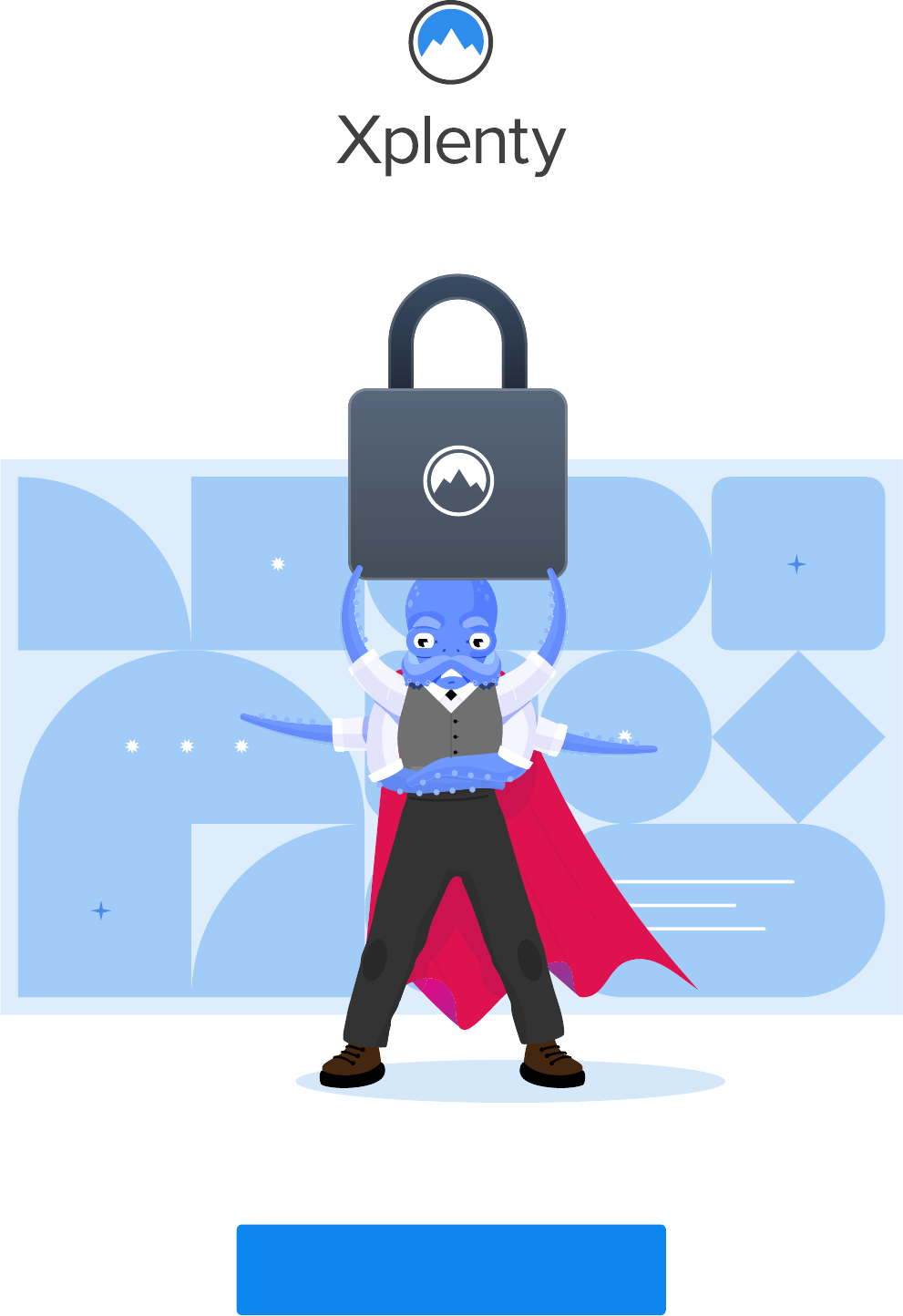
The Complete
Guide to
Salesforce Data
Security
–
Keeping Salesforce
Data Safe

TABLE OF CONTENTS
1. INTRODUCTION TO SALESFORCE DATA 3
2. DEVELOPING YOUR DATA SECURITY POLICY 4
3. UNDERSTANDING DATA SECURITY
COMPLIANCE LAWS 7
4. CLASSIFYING DATA BY SENSITIVITY 9
5. BUILDING A SECURITY STRATEGY
ON IDENTITY 11
6. WORKING WITH A TRUSTED ETL PARTNER 13
7. ESSENTIAL CLOUD ETL DATA SECURITY FEATURES 15
8. 6 SECURITY QUESTIONS TO ASK YOUR ETL VENDOR 17
9. CONCLUSION 20

Businesses of all sizes and industries depend
on customer data in order to beat their rivals
and better serve their audience. The savviest,
most data-driven companies collect vast
quantities of information about individual
customers and potential customers. This
information is then assembled into profiles
that record every last detail—from a person’s
first contact with your company to their most
recent purchase or website visit.
In order to store all this information,
businesses need dedicated software known
as CRM (customer relationship management)
software. There are many CRM options
available depending on your organization’s
goals and requirements, but no CRM software
is as popular as Salesforce. As of 2020,
business intelligence firm IDC estimates
that Salesforce has an 18% CRM market
share—making it the leader for the seventh
consecutive year—and is used by more than
100,000 companies around the world.
Of course, it’s not just organizations
themselves who can get tremendous value
out of their Salesforce data. There’s no
shortage of malicious actors who would love
to get their hands on the information inside
your CRM system, which contains a great deal
of personal, sensitive, and confidential data.
The types of Salesforce CRM data that
attackers are looking for include:
• Personally identifiable information (e.g.,
name, age, date of birth, gender, mailing
address, phone number, email address, etc.)
• Lifestyle data (e.g., education level, career,
family and marital status, homeownership
status, etc.)
• Psychographic data (e.g., interests,
hobbies, beliefs, preferences, values,
attitudes, etc.)
• Behavioral data (e.g., purchases, website
visits, customer support calls, social media
engagements, etc.)
Having Salesforce data in hand isn’t just
monetarily valuable for malicious actors; it could
also be used for identity theft, impersonation,
or credit card fraud. To preserve the privacy
of your customers—and their trust in your
company—you need to defend against
devastating data breaches and keep your CRM
data secure.
So what’s the best way to keep your Salesforce
CRM data safe? In this white paper, we’ll go
over everything you need to know about
Salesforce data security, including:
• Developing a Salesforce data security
policy
• Understanding the most important data
security laws and regulations
• Classifying your Salesforce data by
sensitivity level
• Finding the right data security partner
INTRODUCTION TO
SALESFORCE DATA
1
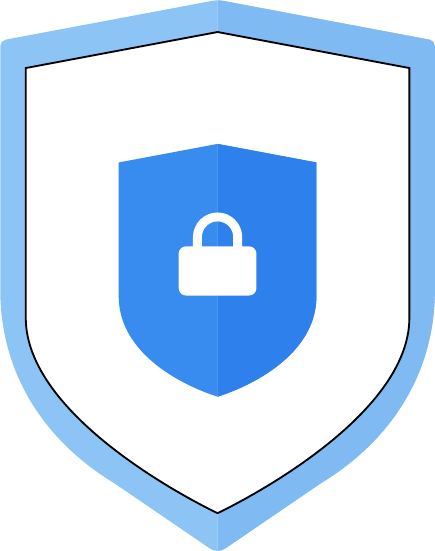
DEVELOPING YOUR
DATA SECURITY POLICY
2
Data security is a philosophy. To protect
against breaches, you have to make data
security part of your core values and live
those values every day. And for that, you
require a Data Security Policy (DSP) that
everyone can access.
Data security policies help to balance the
three main elements of security:
Confidentiality: Sensitive
information must be safe
from prying eyes.
Integrity: Data must
be free from corruption
or loss.
Availability: Data must always
be available for legitimate
business purposes.
These elements, known as the CIA triad, are
sometimes in competition with each other,
but a strong DSP will help you find balance.
C
I
A
• Physical security policy: Standards for
keeping physical devices safe, which
includes entry to the oce building
as well as transportation of electronic
devices.
• Access Control Policy: Rules about
who may access data and how.
• Cloud adoption policy: Guidelines on
implementing cloud-based systems,
including data warehouses and ETL.
• Remote access policy: Outline the
requirements for external access to
local systems.
• Change management policy: The
process for deploying new systems
or procedures, such as minimum
documentation requirements.
• Business continuity and disaster
response plans: A plan for what
happens in the event of a disaster or
catastrophic failure.
• Technical guidelines: The DSP may
outline specific technical standards for the
organization. This can include things such as:
• Operating systems.
• Database management systems.
• Encryption standards.
• User authentication protocols.
• Remote access tools.
• Analytics and event logging.
• Reporting and oversight: The DSP
will outline an internal audit process to
ensure that all systems meet the agreed
requirements. Any issues will go back to
a specified authority, such as the data
governance team.
• Update procedure: A Data Security Policy
is a living document that grows with the
organization. You’ll need an established
process to review and update the DSP to
keep up with new technology and stay
abreast of new threats.
How to Write a Data Security Policy
Data security policy (or DSP) documents are often
written in dense legal language, usually in the
hope that they might help limit the organization’s
liability in the event of a breach. However,
ignorance or a lack of understanding of your
company’s data security policy doesn’t constitute
a legal defense in the event of a breach.
Instead, it’s usually better to write a DSP
in plain language that most people can
understand. Doing so means that the
DSP document acts as a useful guide for
employees, customers and partners, helping
them understand how to keep data safe.
Your DSP document will generally include
the following sections:
• Purpose: Your main goals, which helps
readers understand the spirit of the law.
Examples of such goals are: protect
customer confidentiality; safeguard
business reputation; comply with relevant
laws; proactively work to minimize the risk
of breaches.
• Scope: What does the DSP cover? The
section will explicitly scope in sensitive
data such as PII and classified information.
It’s also useful to scope out certain things,
such as publicly available information and
non-sensitive data.
• Data classification: An overview of how
you classify data, ranging from Public to
Highly Sensitive. We’ll look at this in more
depth in chapter 4.
• Policies: A list of fundamental policies that
relate to all data activity on the network.
This will include things like:
• Acceptable Usage Policy (AUP):
Terms and conditions for people using
your network, such as employees or
customers, who may need to sign a
copy of an AUP agreement.
• Data in transit rules: Standards for
data transportation, including minimum
levels of data encryption.
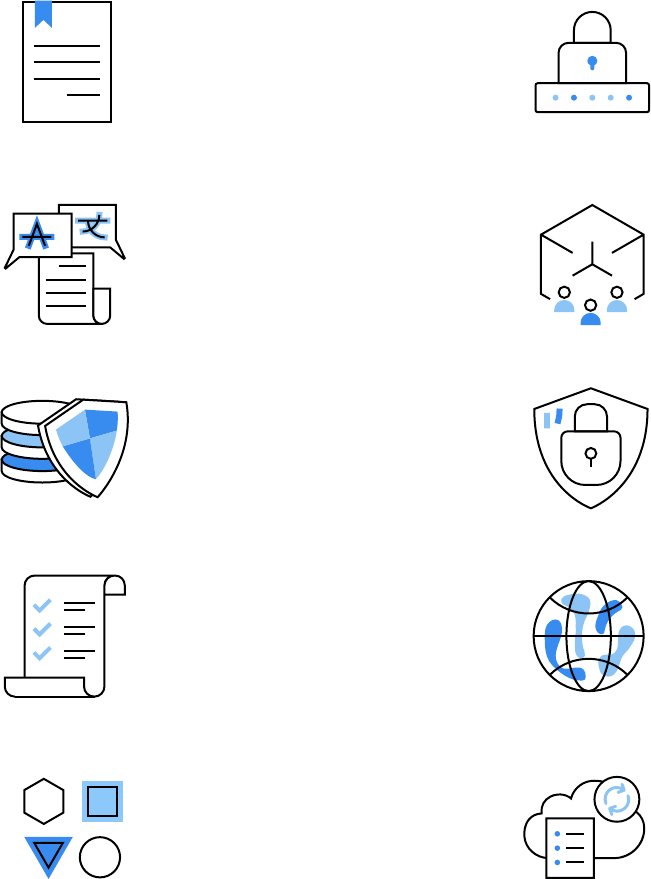
Is there a framework for
working with trusted partners?
(see chapter 6)
Data Security Policy checklist
A data security policy can’t cover every
eventuality. Instead, the goal is to create
a framework that oers guidance when
someone needs to make a decision about
your organization’s data. Here is a checklist of
questions to help establish if your document
meets standards.
Have you clarified the DSP with
all major stakeholders, including
your executive team, I.T., H.R.
and compliance?
Is the document written
in clear language?
Do your policies accord with
all compliance requirements?
(see chapter 3)
Have you categorized data
according to sensitivity?
(see chapter 4)
Have you clarified rules about
permissions and access roles?
(see chapter 5)
Is there a clear Acceptable
Usage Policy for general users?
Have you established a way to
ensure that everyone follows
DSP guidelines?
Is it easy to update the
document as required?
Once you have answered these questions,
you’re ready to publish your security policy.
It’s good practice to try to engage people in
conversation about the policy, using channels
such as eLearning tools or discussion
seminars.
Have you outlined your
primary data security goals?
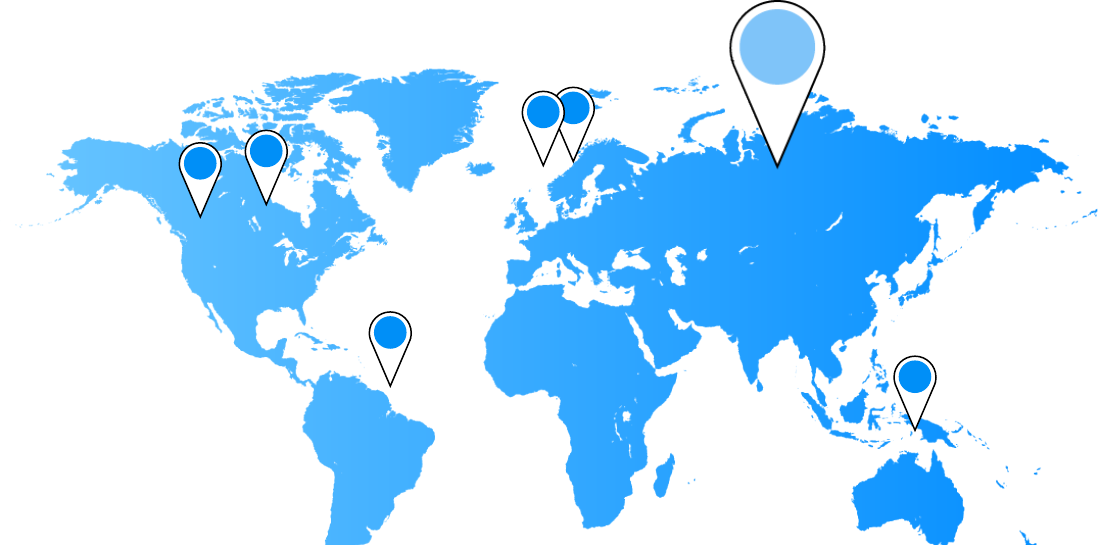
UNDERSTANDING DATA
SECURITY COMPLIANCE
LAWS
3
Data security practices are closely related to
the legal concept of data protection. Under
data protection rules, organizations have an
obligation to protect individual confidentiality.
This means that you have to keep data safe,
prevent unauthorized access and only use
data for legitimate purposes.
Data protection laws vary across countries
and even between states. However, many
laws have an extra-territorial eect, which
means that authorities will punish foreign
companies for breaches.
Main data security compliance laws
Here are a few of the primary laws you need
to be aware of:
1. General Data Protection Regulation (GDPR)
2. Bundesdatenschutzgesetz (BDSG)
3. Health Insurance Portability
and Accountability Act (HIPAA)
4. California Consumer Privacy Act (CCPA)
5. Australian Privacy Act of 1988
6. Lei Geral de Proteção de Dados (LGPD)
5
4
3
6
2
1

General Data Protection Regulation
(GDPR)
Primary jurisdiction: European Union
Data covered: Any data that could potentially
identify an E.U. citizen
Website: https://gdpr-info.eu/
Notes: GDPR is one of the most stringent
dt protection regimes in the world.
Companies must allow users to opt out
of data collection, and they can only
capture PII for essential business purposes.
Organizations face severe restrictions on
transporting PII out of Europe, even when
using a third party service. The E.U. has
successfully fined a number of American firms
for GDPR breaches, including Google
5
.
Bundesdatenschutzgesetz (BDSG)
Primary jurisdiction: Germany
Data covered: Any data that could potentially
identify a German citizen
Website: https://www.gesetze-im-internet.de/
englisch_bdsg/index.html
Notes: E.U. member states can introduce
their own laws to supplement GDPR.
Germany is the only state to have done so to
date, with the BDSG law that imposes stricter
controls and steeper fines. German citizens
can claim for non-monetary damages such as
stress and suering under BDSG.
Health Insurance Portability and
Accountability Act (HIPAA)
Primary jurisdiction: United States
Data covered: Protected Health Information
of Americans
Website: https://www.hhs.gov/hipaa/
Notes: HIPAA refers specifically to health
information about an individual, which
includes medical records and biometric
information. Under HIPAA, data handlers
must ensure confidentiality, integrity and
availability of all relevant information. They
must also take steps to prevent breaches and
unauthorized access.
California Consumer Privacy Act
(CCPA)
Primary jurisdiction: California
Data covered: Personal Identifiable
Information (PII) of Californian consumers
Website: https://oag.ca.gov/privacy/ccpa
Notes: CCPA grants consumers more power
over their PII, including the right to know
what’s on file, the right to request deletion
and the right to opt out of the sale of PII. In
the event of a compliance breach, consumers
can directly sue the company. This law is
currently unique in the U.S., but it is the
template for forthcoming legislation in other
states
6
.
Australian Privacy Act of 1988
Primary jurisdiction: Australia
Data covered: PII of Australian citizens
Website: https://www.ag.gov.au/rights-and-
protections/privacy
Notes: Australia amended its 1988 Privacy
Act in 2017 to cover digital communications.
The act takes a principles-based approach
to compliance, so companies have some
freedom as long as they follow the spirit of
the principles. Since 2018, companies have
been obliged under the Privacy Act to notify
Australian authorities of data breaches that
may cause harm to an individual.
Lei Geral de Proteção de Dados (LGPD)
Primary jurisdiction: Brazil
Data covered: Any data that could potentially
identify a Brazilian citizen
Website: http://www.planalto.gov.br/
ccivil_03/_ato2015-2018/2018/lei/L13709.htm
Notes: Brazil’s LGPD is one of the first
international law to model itself on the E.U.’s
GDPR. As with European law, the LGPD
covers a wide range of personal information
and has an extra-territorial eect on foreign
companies. However, LGPD is generally less
punitive in terms of fines and enforcement.
CLASSIFYING DATA
BY SENSITIVITY
4
Data classification hinges on one question:
What would be the consequences if this data
leaked?
If you consider this question in terms of
your company’s data, you see three main
categories:
• High Impact
This category includes personal
information that could breach data
protection laws or expose people to
the risk of identity fraud. It also includes
sensitive corporate documents such
as confidential reports and strategy
documents.
• Moderate Impact
This includes information that you’d
rather keep private, but which poses no
immediate risk. For example, B2B invoices
and supplier agreements may fall into this
category, as well as personal information
that doesn’t identify an individual.
• Low Impact
This information won’t hurt your business
if leaked, and much of it may already be
available to the public. Press releases,
white papers, and non-proprietary
corporate information all fall into this
category.
Companies can use this system to create a
classification taxonomy for data. Some of the
more common systems use Public, Internal,
Confidential, and Restricted. You can create
further compartments within these general
accepted categories as well.

How to classify personal data
Most privacy laws define PII as information
that could potentially reveal someone’s
identity. Clearly, this includes unique
identifiers such as:
• Name
• Address
• Date of birth
• Login credentials
• Social security
• IP address
• Biometric information
It doesn’t mean that all records associated
with an individual automatically count as PII.
For example, a register of login times for a
user account is personal information, but it is
not necessarily identifiable.
That said, data owners must bear in mind that
minor pieces of data can reveal someone’s
identity when combined. A study by Sophos
found that a combination of gender, date
of birth and ZIP code is enough to uniquely
identify 87 percent of U.S. residents
7
.
When in doubt, it’s best to assume that all
personal records count as PII until you’re sure
otherwise.
Expanding your data classifications
The system above describes an outcome-
based data classification system. Some
organizations may choose to add extra
layers of detail to create a more expressive
taxonomy that describes multiple types of risk.
Some of the extra factors to consider are:
• Frequency of movement
Data is at risk when it keeps moving
between locations. Conversely, the
risk decreases when the data remains
encrypted in a secure repository and
rarely moves.
• Encryption and password protection
Additional measures can help lower risk,
such as password protecting files or
encrypting them in transit. It’s not always
possible to encrypt in-use data, so this
increases the potential risk.
• Access level
The more people with access, the greater
the risk. If data rests in a highly restrictive
environment, it’s low risk. Data on a live
system with multiple users is at a much
higher risk.
• Compliance impact
Some organizations choose to classify
data according to legislation. Health data
poses a high risk of HIPAA breaches, while
E.U. data could lead to a GDPR issue.
Classifying data helps to support data
security while also improving performance.
If you arrive at a set of definitions that meets
your business needs, you can make sure
that highly sensitive data always has the
best possible protection. Then you can
focus on improving processing eciency for
low-risk data.
BUILDING A SECURITY
STRATEGY ON IDENTITY
5
Users tend to be the weakest point of any
network. Cybercriminals often focus on
stealing login credentials through phishing
or social engineering attacks. When they
succeed, they can virtually walk through the
front door unchallenged. Rogue or poorly
trained employees may also pose an internal
threat to data security.
This threat is greater in an age of remote
working and BYOD policies. To meet this
challenge, we have to change the way of
thinking about user security. Instead of being
a weakness, user identity can be the primary
perimeter for data security.
The Identity Perimeter
• Users have a single login with strong
authentication, including multiple factors
• Analytics-powered systems monitor each
identity for unusual activity
• All data activity is tied to a specific user
identify
• Role Based Access Control (RBAC)
• Compromised identities are easy to
deactivate or delete
Key elements of an identity-based
strategy
An identity strategy must respect all three
elements of the CIA triad:
• Confidentiality
User data is never exposed to an
unauthorized party. Equally, users cannot
access another person’s data unless they
have a good reason.
• Integrity
Users must have access to quality data
and be able to amend as required.
Users should not be able to make any
unauthorized changes or deletions.
• Availability
Users should have access to the data they
require with as few barriers as possible.
Identity strategy is about finding a balance
between these elements. If your measures
are too complex and restrictive, users won’t
be able to work with your system, which may
force them to adopt risky workarounds. If
your measures are too lax, you risk exposing
sensitive data.
In practice, it’s often a matter of implementing
a system and then fine-tuning it according
to your business needs. Follow the best
practices below to find a balance that works.
Identity strategy best practices
• Oer single sign-on
Multiple logins can pose a risk. Users tend
to forget multiple passwords, so they end
up reusing logins or, even worse, keeping
a list of passwords on their desk. Single
sign-on means that one username, one
password, and one user identity linked to
all data activity.
• Set strong password standards
Password best practice techniques
include:
• At least 12 characters
• Variety of ASCII characters, including
letters, numbers, and symbols
• Forbid the use of names, dictionary
words or dates
• Check against a password dictionary to
see if a password is commonly used
• Use randomly generated passwords
where possible
• Use two-factor authentication (2FA)
2FA is essential in a single sign-on
environment. By requiring two forms of
authentication from two dierent sources,
it adds an extra step that most hackers
can’t replicate, even if they obtain a
username and password. Typically you will
use two of the following “factors” for your
authentication:
• Something you know (e.g. a password)
• Something your have (e.g. phone,
keys, etc)
• Something you are (e.g. biometrics,
fingerprints, etc)
• Implement role-based access control
Each individual identity should be linked to
a role, such as sales, analytics, customer
service, etc. You can then implement a
data access policy that reflects each role’s
needs, giving everyone the data they
require. In the event of an organizational
change, you can then change the
configuration for a role rather than
updating individual users.
• Take a “least privilege” or “need to know”
approach
Each role should have access to the data
they need, but nothing else. This approach
limits the chances of unauthorized data
access by a rogue user, or via stolen login
credentials.
• Communicate with your users
In the perfect identity-based strategy,
users will have a seamless data
experience, while unauthorized parties
will find it impossible. It’s only possible to
reach this level by working with your users
and ensuring that they have the right
level of data availability and an easy login
process.
Education plays a vital role in this strategy.
Ensure that everyone receives adequate
training and support to understand how
identity management plays a role in
organizational security. Let them know what
they need to do to keep data safe.

WORKING WITH
A TRUSTED
ETL PARTNER
6
Extract, Transform, Load (ETL) is a core
process that allows you to store data in a
secure repository. The process goes like this:
• Extract: Obtain data from live production
systems, such as CMS, ERP, eCommerce,
marketing automation and so on.
• Transform: Integrate and transform
the raw data so it’s suitable for storage
in a data repository.
• Load: Send the transformed data to a
secure storage location, such as a data
warehouse.
During this process, the data passes
through each of the three data states,
as shown here →
Data in transit can be vulnerable, especially
when it is moving outside of the on-premise
data environment, so must be encrypted.
As most organizations are now reliant on
cloud-based warehouses, this kind of data
movement is an inevitable fact of life.
The main approaches to ETL are to build
your own solution, install an o-the-shelf ETL
locally or use a cloud ETL service.
Production
System
ETL Data
Pipeline
Data
Warehouse
In use
In transit
At rest

How do Cloud ETL providers
guarantee data security?
Cloud-based ETL provides your data with
a single point of egress from the network.
Rather than having multiple pipelines
connecting each production database to a
repository, each production system has a
secure connection to the ETL service. The
ETL then has a separate connection to the
data repository.
Data makes a pitstop on the ETL servers,
where it passes through the transformation
layer. With in-house or local solutions, this
stage can be vulnerable.
However, a good cloud ETL provider such
as Xplenty takes significant steps towards
protecting data security. This includes things
like:
• Security-first development process
Any reputable ETL vendor will start with
security protocols before they even begin
developing the service. As a user, you can
identify trustworthy products by examining
their security details and seeing if the
provider has baked security into their
product.
• Physical security
The physical location of your data in
transition is a major factor in security.
Reputable vendors will guarantee that all
servers are safe. Xplenty uses an AWS
infrastructure, which sits on Amazon’s
SOC-compliant data centers.
• Working with reputable vendors
ETL is an interactive product by nature,
with automatic integration to other
services. ETL vendors must carefully vet
and monitor all of their partners to ensure
that their customers are not exposed to
risk. The ETL vendor also stays on top
of changing API requirements to ensure
that integrations always meet current
requirements.
• Plans for disaster recovery
ETL vendors provide a critical connection
between live systems and repositories.
Real-time analytics services are
dependent on an uninterrupted flow of
data between these points. The ETL
vendor should have a robust plan for
maintaining service in any circumstances.
• SOC 2 compliance
Routine testing is a requirement of this
security standard. Xplenty, for example,
undergoes third-party penetration testing
each year. When choosing an ETL vendor,
ask to see their SOC 2 report & PenTest
results before signing up.
What is it? Pros Cons
In-house development Internal dev team creates a
bespoke ETL for your specific
needs
Full control and transparency of
all aspects of ETL
You need an in-house team
to build the solution and
provide ongoing support
Local ETL Install Purchase an ETL solution and
install it on your on-premise
infrastructure
Control over configuration
without needing to develop the
software from scratch
Dicult to upscale and may
not integrate securely with
cloud-based warehouses
Cloud ETL A third-party service manages
your ETL needs across the
cloud
Simple, no-code integration
with cloud and on-premise
services, with a trusted partner
guaranteeing security
Works best with other cloud
services, such as AWS,
Salesforce, and cloud-based
analytics tools
• SSH/Reverse SSH tunnel
The best ETL vendors will allow you
to connect without compromising your
security. This usually involves an SSH
tunnel or reverse SSH if you can’t provide
port access. Xplenty supports both SSH
and reverse SSH.
• Non-persistent data
ETL should transport your data from A to B
with no records in-between. This means no
copies, no archives, no logs – nothing that
might inadvertently cause a risk of a data
breach. Look for a service like Xplenty that
guarantees the non-persistence of all data
passing through the pipeline.
• Data encrypted in transit, and at rest
Within the ETL process itself, data is
sometimes at rest or moving between
locations. The vendor should be able to
guarantee robust encryption for in transit
and at rest throughout the ETL process.
• Regular penetration testing
As per SOC 2 requirements, penetration
testing occurs regularly. You might request
the PenTest reports when signing up, but
remember to keep checking them each
year while you’re signed up for the service.
Any cloud ETL service should oer these
as a minimum.
ESSENTIAL CLOUD
ETL DATA SECURITY
FEATURES
7
There are many cloud-based ETL providers on
the market, each oering a range of attractive
features. For example, Xplenty oers benefits like:
• High-speed transformations on a staging
server
• Automated integration with most major
production systems and data repositories
• No-code data pipeline automation
• 24-hour support and error recovery
But security is the most crucial aspect of any
ETL solution. If a vendor can’t oer a full suite
of security options, then it’s worth shopping
around for someone you trust.
Key data security features
As discussed in the previous section, there
are certain things that you should verify
about each vendor, such as SOC compliance,
physical security and reputation.
It’s also a good idea to look at the data
security features they oer to users. The most
important ones are:
• Secure login
Your team will access the Cloud ETL service
through a web interface. This interface should
oer a secure connection with outstanding
authentication features, including 2FA and
suspicious activity detection. Do they oer
Single Sign On (SSO)?
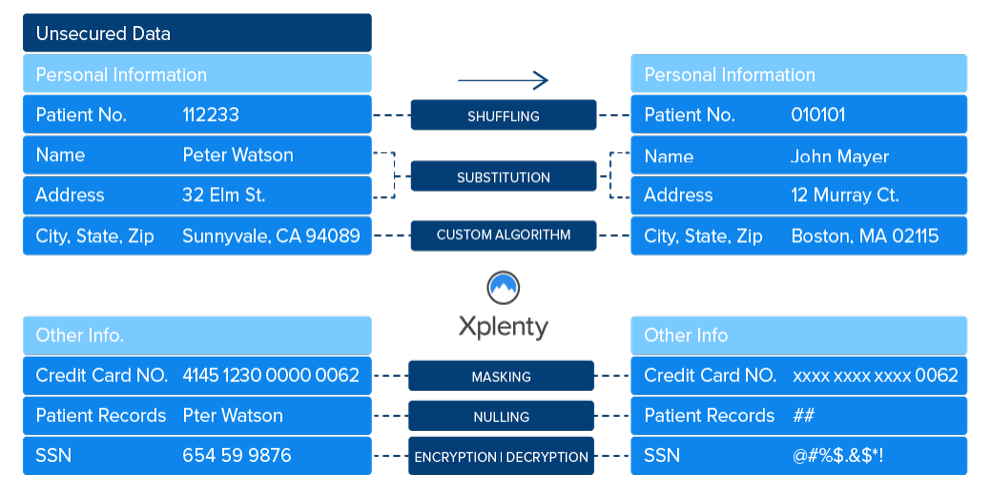
Security through data transformation
ETL can also improve your overall level
of data security by oering transformation
functions that protect sensitive data.
• Field-level encryption: Field level
encryption means that data is always
encrypted when it leaves your network.
Decryption is impossible without the
key, which you hold on your side. Should
anyone intercept or access data while
it’s outside of your network, they won’t
be able to decrypt it. Xplenty oers field-
level encryption using Amazon’s Key
Management Service (KMS), and you can
use this to encrypt data at any stage in the
ETL process.
• Hashing: Hashing is a one-way
cryptographic function that replaces
sensitive data with a meaningless value.
For instance, you can configure your ETL
to replace social security numbers with a
set of random characters.
• Masking: Masking is commonly used in
testing and analytics scenarios, where
your team might need large volumes of
representative data, but they don’t need
genuine personal information. An ETL
masking layer will produce an arbitrary
value that meets requirements but doesn’t
expose personal information. For example,
the ETL platform could replace Social
Security numbers with a random 9-digit
number.
• Obfuscation: Obfuscation is a way of
hiding data values that is often reversible.
For instance, the ETL may replace certain
values with codes from a lookup table.
That lookup table later makes it possible
to restore the original values.
ETL can help to minimize risk to data in transit
by hiding or removing sensitive information.
This is the ultimate data security strategy –
if someone does intercept or access the data,
they won’t find anything of value.

1. How can your platform help protect
our PII, PHI, and other sensitive data?
There’s no one-size-fits-all approach to data
security, so your vendor shouldn’t oer a one-
size-fits-all answer to this question. Instead,
they’ll talk to you about your particular needs
and explore issues like:
• What kind of sensitive data do you collect?
• How do you store and process this data?
• What territories do you operate in?
• Who is using the data?
• What kind of production systems and
storage solutions are you using?
• What are your analytics objectives?
This will help them understand your needs
and also to identify potential risks in your data
strategy. The vendor should then be able to
suggest ways that their ETL solution will be
able to help.
2. What examples can you share of
how you have helped other clients
with their data security?
Many ETL vendors have worked on big
projects for major organizations. They’ll have
experience with complex data infrastructures,
and they’ll know how their solution can
address real-world problems.
Ask your vendor for case studies and
testimonials to show that they have this kind
of background. This will allow you to gauge
their reputation and see if you’re working
with someone you can trust. Case studies
will also let you know if they have dealt with
organizations like yours in the past.
6 SECURITY
QUESTIONS TO ASK
YOUR ETL VENDOR
8
The right ETL vendor can have a massive
impact on your overall level of data security.
As with any professional partnership, it’s
essential to get o on the right foot. You can
do this by looking at the product features
and asking whether they truly align with your
needs.
More importantly, try to have a conversation
with your vendor. Talk to them and see if
they understand your needs. Here are a few
questions to ask when you approach a vendor.

3. What features does your platform
have to maintain compliance with
regulations such as GDPR, CCPA,
HIPAA?
Any reputable vendor will already be
compliant with all major regulations.
For example, Xplenty ETL meets the
requirements of GDPR, transforming data
in the EU, and oers an updated Data
Processing Addendum (DPA) to support
customers’ GDPR compliance needs.
Your vendor should understand how
regulations might impact you and oer advice
on how to stay compliant. Remember – you
are the responsible party if your third-party
ETL service causes a compliance breach.
Protect yourself by choosing a partner that
understands the law.
4. How can your data security team
assist with our data security strategy
and implementation?
If your ETL vendor has a security-first
mindset, they’ll be able to oer advice
and suggestions about keeping your data
safe. They may oer some resources on
building an eective data strategy, as well
as guidelines on meeting standards such as
SOC 2.
The simplest way that ETL vendors can
help is by oering a secure one-to-one data
pipeline between systems. This is much more
secure than the many-to-one architecture of
some infrastructures.

5. How do you remove/encrypt
sensitive data in Europe for GDPR
before moving data to the U.S. or
elsewhere for centralized analysis?
Moving data across national borders is
increasingly tricky in terms of compliance.
Unfortunately, most organizations need to
move data internationally. Even if you don’t
have an oce abroad, you might use an
accounting, analytics, or storage service
based in another country. Sending data to
them could put you in breach.
ETL makes things much easier by oering
tools such as data obfuscation and field-
level encryption. These transformations
(performed in an EU data center) can make
data compliant before transit. You can then
allow your data pipeline to run as normal
without worrying about breaches.
6. Does your platform support field-
level encryption for sensitive data
fields?
Field-level encryption is the most secure way
to protect personal information. Encryption
happens before data leaves your network,
and there’s no way to decrypt it without the
relevant key. It’s a failsafe system – if hackers
manage to access your data, they won’t be
able to interpret it.
It’s important to ask whether your vendor
oers field-level encryption. Also, ask them:
• Which encryption service do you use?
• How does your ETL handle encryption?
• How do I encrypt and decrypt data in the
pipeline?
With Xplenty, you can encrypt and decrypt
from the expression editor, using the
Encrypt() and Decrypt() commands.
CONCLUSION
_
In a global, digital world, the most important
currency for any business is trust.
Trust is something you earn over many years
by diligently safeguarding your customer’s
personal data. They trust you with a lot of
essential information – their address, their
payment details, their preferences, even their
biometric data.
But trust is something you can lose in an
instant. All it takes is one lapse in data
security, and nobody will ever trust you
again. They’ll switch to a rival that takes data
security seriously, someone that always
protects customer confidentiality.
Data security isn’t easy. Cyberthreats are
constantly evolving, and employees struggle
to keep up with ever-changing protocols. The
new normal of remote work has added another
layer of risk to an already challenging world.
This is why it’s more important than ever to
get data security right. It starts with strategy,
with people and with education. But the most
important part is getting the infrastructure
right. A good ETL vendor can help you build
a secure data pipeline that keeps sensitive
information out of the wrong hands. Your
customers will rest easy knowing their
personal data is safe.
